If you’re following me on Facebook you may have seen a photo I posted this week of a lovely find I recently received in the mail- several years of bound Ladies Home Journal magazines. I have been itching to share some of the content with you, so today we’ve got hats and bonnets from the April, 1897 issue. The layout of this page made it quite hard to share a scan (the magazines are a large format), and the layout was bizarre with very small pictures, so I have transcribed the article here, complete with the remastered pictures a little larger than they appeared in the original.
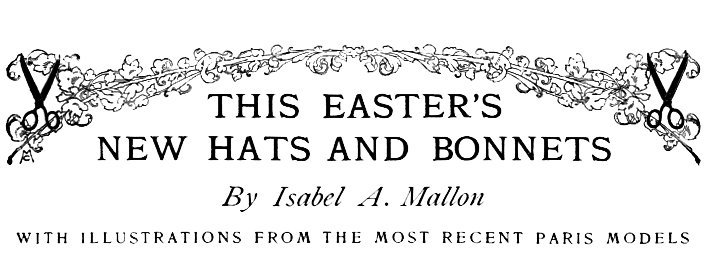
The fashionable materials for this Easter’s hats and bonnets are chip, manilla, Leghorn, Neapolitan, Madagascar and English straw, and all the straw braids, especially those imitating satin. Black velvet is largely used for trimming with moiré and stain ribbons, deftly looped. Ostrich tips and long feathers are in vogue, though flowers are given preference over everything. The big Parma violets, as well as the enormous roses and poppies that were so generally used last season, continue to obtain, while camellias, tuberoses, white lilies, lilies-of-the-valley, blue hortensias, ragged robins and primroses are counted as quite new.
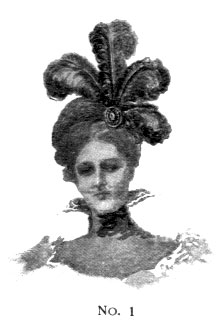
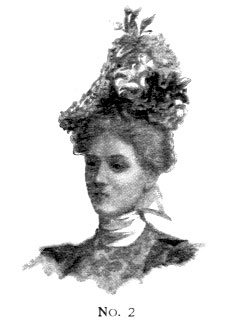
An extremely smart little bonnet (no. 1) is made of dull red straw, the front being turned back, exposing the hair, somewhat after the fashion of a Scotch cap. Very slightly to one side of the front is a bunch of black ostrich plumes, caught in place by a Rhinestone clasp. The simplicity of this bonnet is its special charm, while its style is cited to show that the woman who looks best when her hat is off her face has been considered. A little bonnet (No. 2), which may or may not have ties, has a small frame covered with a drapery of white satin embroidered with jet, turquoises, and silver spangles. It is raised on the left side and decorated with pink camellias and one large black silk poppy.
Click the link below to continue reading. If you see no link, you’re in the right place!
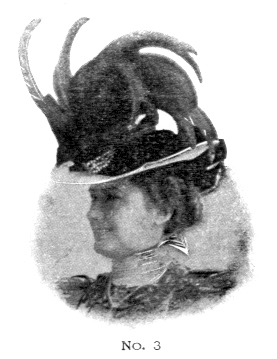
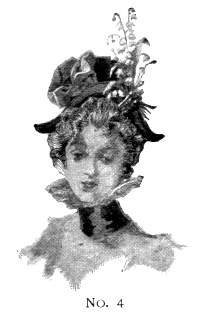
One of the prettiest of the large hats (No. 3) is made of pale lavender satin braid, so wrought that it has a rather square crown, and a broad, but soft, brim curving up at each side. It is trimmed about the crown with a twist of black velvet, and from the front, and falling over the crown in artistic disorder, is an enormous bunch of cock’s feathers. Under the brim at the back are black velvet loops. A smart chapeau (No. 4) has a Napoleonic look it is made of black chip, and fitted carefully to the head before it is trimmed. On one side is a knot of dull poppy velvet, cleverly twisted so that it looks almost like a flower; on the other is a high bunch of lilies-of-the-valley, which stands up in aigrette fashion and is clasped under a jeweled ornament.
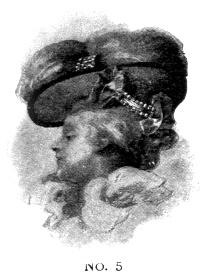
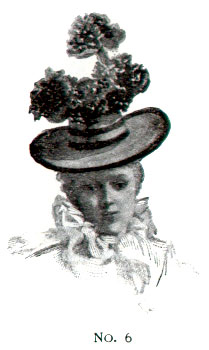
The large hat (No. 5), which looks more elaborate than it really is, is of pale gray chip, with a broad brim and a rather high crown. Starting from under a buckle of Rhinestones at one side are two ostrich plumes which fairly encircle the crown; the brim is turned up at the back, and on each side are two knots of gray satin ribbon, with a clasp of Rhinestones between them. A flower-trimmed hat (No. 6), which is in reality the ever-popular sailor shape, is made of English braid. The stiff brim is bound with black velvet, and about the crown are two narrow bands of the velvet. Coming up from the back and directly over the crown is a high, full cluster of jacinths. The brim of the hat is slightly raised at the back, with a band of the flowers under it, resting upon the hair.
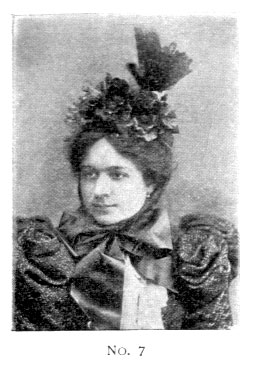
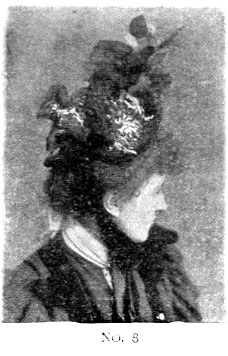
A particularly pretty bonnet (No. 7) for the woman who likes her capote to have ties to it is here shown. It is small and of red straw. In front poppies are artistically arranged, while at the back, placed so that it shows well from the front, is a high pompon of black lace, fastened in place by a paste jewel; the ties are red watered ribbon. A bonnet of this style may be developed in any colors that are fancied, and roses may be substituted for the poppies; or, if preferred, the bonnet itself may be black and the poppies in contrast.
Another bonnet (No. 8) with strings is also illustrated. It is a Dutch cap in shape, and made of the yellow straw braid which was seen last season, and which, it is more than probably, will be greatly liked this year. The edge is draped with garnet-colored velvet, which droops down at the back, forming the ties. In front are fans of fine black lace, which seems to surround a large spray of dark red roses and their foliage; at the back are loops of lace, and between them a bandeau of rosebuds with their delicate leaves.
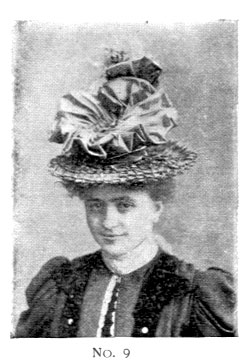
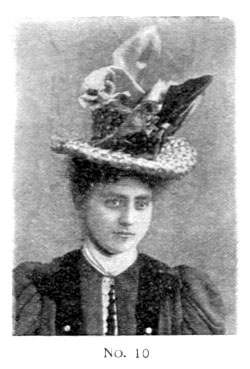
After allowing one to look at some pretty bonnets the clever millinery distracts attention by showing a hat like No. 9. It is made of shiny straw braid of a lovely soft green; the turban crown is of mauve satin, while from the back there come up, high above the crown, loops of satin of the same shade, and big white chrysanthemums. Another hat (No. 10) forces one to recognize the popularity of violet. It is made of violet raphia, and has a square crown, and a thick-looking brim, which is, however, light in weight because it is hollow; it is decorated with loops of pale mauve satin just in front, with loops of pale green satin at the back, and from the back on to the crown comes a bunch of white silk poppies.
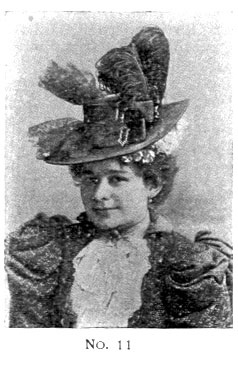
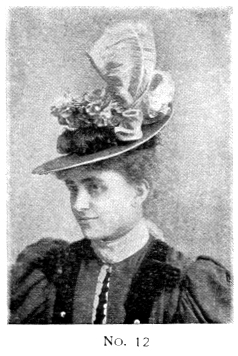
A simpler hat (No. 11), one intended to be worn well over the face, is of fine black straw, trimmed with bands of black satin ribbon about the crown, which end in loops under small steel buckles in front. Frills of black lace are on one side and black plumes on the other. The side trimmed with plumes has the brim slightly raised, and under it is a garland of small flowers. The contrast of feathers and flowers i well shown not only in this hat but also in No. 12, which is made of black chip, has a straight, broad brim faced with pale pink chip, and medium high crown. The lower part of the crown is circled with black ostrich tips, and the upper with shaded pink poppies. At one side are loops of fine pink ribbon, which, before being looped, have been shirred on invisible wire, so that they have a feathery look.
A French critic has said: “The American women long ago determined to become beautiful, and they have devoted to this aim more systematic and hygienic training than any other nation has ever thought of, and they have been marvelously successful.”
Speaking of fashions he goes on to tell how the American woman unconsciously takes the best of the French fashions because they have a distinct individuality. The French millinery studies each woman; and the American woman, as no other woman has done, appreciates that the best compliment that a French milliner can pay to a bonnet when she says, “Il est très coiffant,” meaning that the bonnet is not only adapted to the woman, but so well suited to her hair and head as to form a satisfactory whole.
It is not so long ago since millinery bought their straw hats and trimmed them, but nowadays the clever milliner makes to order bonnets or hats to suit the special requirements of her customers, to each one of whom she gives an individuality.
As an aside, I need to make more use of phrase “artistic disorder”. How apt a description! And don’t some of these hats remind you of that the Pratt sisters wear in Lark Rise to Candleford?

Dawn
April 7, 2012 at 5:47 am (12 years ago)Like hat No 1. I have a mess of peacock feathers that I intended for an outfit (that is currently on hold) but wasn’t sure how I’d use them. I think this is it!
Corinne
April 7, 2012 at 6:56 am (12 years ago)Oh my! What an amazing collection. Never a hat girl I was always amazed at those ladies who looked fabulous in theirs. Thanks for this little look at the past.